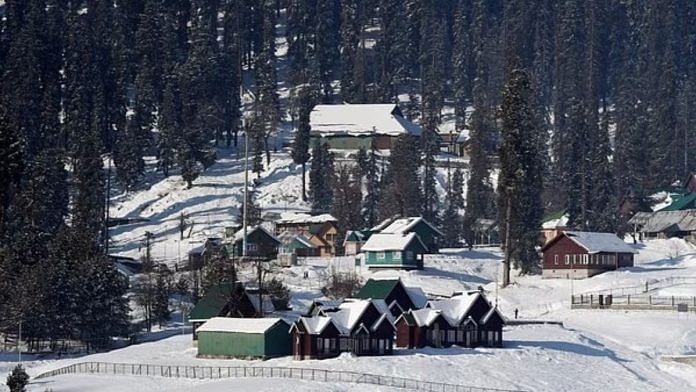Thank you dear subscribers, we are overwhelmed with your response.
Your Turn is a unique section from ThePrint featuring points of view from its subscribers. If you are a subscriber, have a point of view, please send it to us. If not, do subscribe here: https://englishdev.theprint.in/subscribe/
Kashmir has always been more than a mere place. It has the quality of an experience, or a state of mind, or perhaps an ideal”- that is how Jan Morris described the ‘Paradise on Earth’, that is, the Indian state of Jammu & Kashmir. What makes Kashmir the ‘Jewel in the Crown’ is not only its strategic geographical location but also the profound beauty it inherits in its arms. The meandering rivers, charming lakes, untamed and unspoilt valleys, stunning white landscape during winter, delightful and vibrant atmosphere during autumn and much more. These are the facets that make Kashmir a much-desired location for spending holidays and a dream destination to propose to one’s partner.
However, the geo-political environment of Kashmir has not always remained as romantic as its natural beauty. It has been continuously married in disputes due to several factors. Foreign invasions, differing claims over its territory, communal riots and provocative calls for indulging in violence for ‘the sake of violence,’ to name a few.
When the country gained freedom from British rule in 1947, the rulers of Princely states were allowed to join either of the two dominions (India or Pakistan) or to remain independent. Maharaja Hari Singh, the then-ruler of Kashmir, hesitated in making a decision. He faced pressure from Mohammad Ali Jinnah to align with the sentiments of the Muslim majority and join Pakistan. Given his own Hindu identity, the Maharaja proceeded cautiously, taking time to weigh the implications of his decision. But the attack of October 1947 on Kashmir by armed Pakistani tribesmen left the Maharaja with no choice. During the attack, the armed tribesmen went on a rampage- killing hundreds of locals, looting thousands and giving unbearable pain to the soul of Kashmir by raping its women and even small girl children. The Maharaja was convinced that Pakistan was not demanding Kashmir for its ‘shared identity,’ but in its quest to satisfy its ego. In the wake of this attack, he signed the Instrument of Accession with India.
The dispute should have become settled then as the ruler had finally taken his decision, as every ruler of Princely states was supposed to. But his Hindu identity became an obstacle. Allegations arose that he did not represent the will of the people, as the majority were Muslim. Before
As the political landscape evolved, the implications of the Maharaja’s decision became increasingly significant, especially in light of Modi’s New Kashmir promise which aimed to redefine the region’s relationship with India.
joining India, the Maharaja had been in a state of conundrum and had delayed his decision. Therefore, the arguments made above seemed legitimate.
What followed in the coming years cleared the clouds hovering over the ‘will of Kashmiris’. In October 1950, Sheikh Abdullah, one of the tallest Muslim leaders of Kashmir, demanded elections to create a constituent assembly to determine Kashmir’s future relationship with India. In September 1951, elections to the constituent assembly were held, and Sheikh Abdullah argued for accession to India. In February 1954, the constituent assembly ratified the accession to India. The assembly, chosen by the public, had put the stamp of approval on the Maharaja’s decision.
But Jawaharlal Nehru’s decision to refer the Kashmir issue to the United Nations and the hope of ‘Aazadi’ given by some separatist leaders kept the people of the valley in a state of dilemma detached from reality. This led to decades of violence in the ‘Paradise on Earth’ engulfed by communal riots due to a sense of distrust. Post-2019 it appears that the government has made some attempts to clear this dilemma. The abrogation of Article 370, and the Supreme Court’s approval of it, has made it clear that it is the Indian parliament that holds the sovereign right to determine the status of Jammu & Kashmir.
Decades of violence, unemployment, lack of opportunities and investment have induced a sense of frustration in Kashmiris. The government of the day has taken an offensive defence approach against the violence propagated by the neighbouring country, and to some extent, it has provided an atmosphere of peace and security in the region. This has attracted a large amount of investment in the valley, which in turn would tackle the issue of unemployment to a significant extent in the near future. Tourism has also increased to a comparatively higher level. The government’s collaborative approach with young Kashmiri influencers such as Shehla Rashid and Shah Faisal has created a positive atmosphere in the minds of the younger generation.
All these reconciliatory steps have yielded positive results and will reach a definite conclusion with the free and fair conduct of elections, which is a basic feature of the working of a healthy democracy. A new dawn in Kashmir has begun where the distrust between communities has taken a back seat, and everyone is ready to look forward with an optimistic approach.
These pieces are being published as they have been received – they have not been edited/fact-checked by ThePrint.


